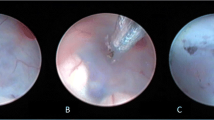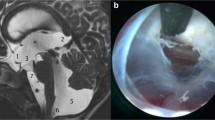Abstract
Background
In case of suspected normal pressure hydrocephalus, MRI is performed systematically and can sometimes highlight an obstruction of the flow pathways of the CSF (aqueductal stenosis or other downstream obstruction). It seems legitimate for these patients to ask the question of a treatment with endoscopic third ventriculostomy (ETV), even if the late decompensation of an obstruction may suggest an association with a CSF resorption disorder. The aim of this study was to evaluate clinical and radiological evolution after ETV in a group of elderly patients with an obstructive chronic hydrocephalus (OCH).
Methods
ETV was performed in 15 patients with OCH between 2012 and 2017. Morphometric (callosal angle, ventricular surface, third ventricular width, and Evans’ index) and velocimetric parameters (stroke volume of the aqueductal (SVa) CSF) parameters were measured prior and after surgery with brain MRI. The clinical score (mini-mental status examination (MMSE) and the modified Larsson’s score, evaluating walking, autonomy, and incontinence) were performed pre- and postoperatively.
Results
SVa was less than 15 μL/R-R in 12 out of the 15 patients; in the other three cases, the obstruction was located at a distance from the middle part of the aqueduct. Fourteen out of 15 patients were significantly improved: mean Larsson’s score decreased from 3.8 to 0.6 (P ≤ 0.01) and mean MMSE increased from 25.7 to 28 (P = 0.084). Evans’ index and ventricular area decreased postoperatively and the callosal angle increased (P ≤ 0.01). The mean follow-up lasted 17.9 months. No postoperative complications were observed.
Conclusion
ETV seems to be a safe and efficient alternative to shunt for chronic hydrocephalus with obstruction; the clinical improvement is usual and ventricular size decreases slightly.



Similar content being viewed by others
References
Adams RD, Fisher CM, Hakim S, Ojemann RG, Sweet WH (1965) Symptomatic occult hydrocephalus with ‘normal’ cerebrospinal fluid pressure. N Engl J Med 273(3):117–126
Balédent O, Henry-Feugeas MC, Idy-Peretti I (2001) Cerebrospinal fluid dynamics and relation with blood flow: a magnetic resonance study with semiautomated cerebrospinal fluid segmentation. Investig Radiol 36(7):368–377
Baroncini M, Balédent O, Ardi CE, Delannoy VD, Kuchcinski G, Duhamel A, Ares GS, Lejeune J-P, Hodel J (2018) Ventriculomegaly in the elderly: who needs a shunt? A MRI study on 90 patients. Acta Neurochir Suppl 126:221–228
Bateman GA, Levi CR, Schofield P, Wang Y, Lovett EC (2005) The pathophysiology of the aqueduct stroke volume in normal pressure hydrocephalus: can co-morbidity with other forms of dementia be excluded? Neuroradiology 47(10):741–748
Benson DF, LeMay M, Patten DH, Rubens AB (1970) Diagnosis of normal-pressure hydrocephalus. N Engl J Med 283(12):609–615
Bergsneider M, Miller C, Vespa PM, Hu X (2008) Surgical management of adult hydrocephalus. Neurosurgery 62(Suppl 2):643
Bret P, Guyotat J, Chazal J (2002) Is normal pressure hydrocephalus a valid concept in 2002? A reappraisal in five questions and proposal for a new designation of the syndrome as ‘chronic hydrocephalus’. J Neurol Neurosurg Psychiatry 73(1):9–12
Duru S, Peiro JL, Oria M, Aydin E, Subasi C, Tuncer C, Rekate HL (2018) Successful endoscopic third ventriculostomy in children depends on age and etiology of hydrocephalus: outcome analysis in 51 pediatric patients. Child’s nervous system. ChNS 34(8):1521–1528
Dusick JR, McArthur DL, Bergsneider M (2008) Success and complication rates of endoscopic third ventriculostomy for adult hydrocephalus: a series of 108 patients. Surg Neurol 69(1):5–15
El-Ghandour NMF (2011) Endoscopic third ventriculostomy versus ventriculoperitoneal shunt in the treatment of obstructive hydrocephalus due to posterior fossa tumors in children. Childs Nerv Syst 27(1):117–126
Folstein MF, Folstein SE, McHugh PR (1975) ‘Mini-mental state’. A practical method for grading the cognitive state of patients for the clinician. J Psychiatr Res 12(3):189–198
Gangemi M, Mascari C, Maiuri F, Godano U, Donati P, Longatti PL (2007) Long-term outcome of endoscopic third ventriculostomy in obstructive hydrocephalus. Minim Invasive Neurosurg 50(5):265–269
González-Martínez EL, Santamarta D (2016) Does aqueductal stenosis influence the lumbar infusion test in normal-pressure hydrocephalus? Acta Neurochir 158(12):2305–2310
Guzman R, Pendharkar AV, Zerah M, Sainte-Rose C (2013) Use of the NeuroBalloon catheter for endoscopic third ventriculostomy. J Neurosurg Pediatr 11(3):302–306
Holodny AI, Waxman R, George AE, Rusinek H, Kalnin AJ, de Leon M (1998) MR differential diagnosis of normal-pressure hydrocephalus and Alzheimer disease: significance of perihippocampal fissures. AJNR Am J Neuroradiol 19(5):813–819
Isaacs AM, Bezchlibnyk YB, Yong H, Koshy D, Urbaneja G, Hader WJ, Hamilton MG (2016) Endoscopic third ventriculostomy for treatment of adult hydrocephalus: long-term follow-up of 163 patients. Neurosurg Focus 41(3):E3
Jellinger G (1986) Anatomopathology of non-tumoral aqueductal stenosis. J Neurosurg Sci 30(1):1–16
Kim J, Na HK, Byun J, Shin J, Kim S, Lee BH, Na DL (2017) Tracking cognitive decline in amnestic mild cognitive impairment and early-stage Alzheimer dementia: Mini-Mental State Examination versus neuropsychological battery. Dement Geriatr Cogn Disord 44(1):105–117
Kojoukhova M, Koivisto AM, Korhonen R, Remes AM, Vanninen R, Soininen H, Jääskeläinen JE, Sutela A, Leinonen V (2015) Feasibility of radiological markers in idiopathic normal pressure hydrocephalus. Acta Neurochir 157(10):1709–1719
Lacy M, Oliveira M, Austria E, Frim MD (2009) Neurocognitive outcome after endoscopic third ventriculocisterostomy in patients with obstructive hydrocephalus. J Int Neuropsychol Soc 15(3):394–398
Lapras C, Bret P, Patet JD, Huppert J, Honorato D (1986) Hydrocephalus and aqueduct stenosis. Direct surgical treatment by interventriculostomy (aqueduct canulation). J Neurosurg Sci 30(1):47–53
Larsson A, Wikkelsö C, Bilting M, Stephensen H (1991) Clinical parameters in 74 consecutive patients shunt operated for normal pressure hydrocephalus. Acta Neurol Scand 84(6):475–482
Locatelli M, Draghi R, DI Cristofori A, Carrabba G, Zavanone M, Pluderi M, Spagnoli D, Rampini P (2014) Third ventriculostomy in late-onset idiopathic aqueductal stenosis treatment: a focus on clinical presentation and radiological diagnosis. Neurol Med Chir 54(12):1014–1021
Oi S, Shimoda M, Shibata M, Honda Y, Togo K, Shinoda M, Tsugane R, Sato O (2000) Pathophysiology of long-standing overt ventriculomegaly in adults. J Neurosurg 92(6):933–940
Sankey EW, Jusue-Torres I, Elder BD, Goodwin CR, Batra S, Hoffberger J, Lu J, Blitz AM, Rigamonti D (2015) Functional gait outcomes for idiopathic normal pressure hydrocephalus after primary endoscopic third ventriculostomy. J Clin Neurosci 22(8):1303–1308
Tisell M, Almström O, Stephensen H, Tullberg M, Wikkelsö C (2000) How effective is endoscopic third ventriculostomy in treating adult hydrocephalus caused by primary aqueductal stenosis? Neurosurgery 46(1):104
Tudor KI, Tudor M, McCleery J, Car J (2015) Endoscopic third ventriculostomy (ETV) for idiopathic normal pressure hydrocephalus (iNPH). Cochrane Database Syst Rev 7:CD010033
Vulcu S, Eickele L, Cinalli G, Wagner W, Oertel J (2015) Long-term results of endoscopic third ventriculostomy: an outcome analysis. J Neurosurg 123(6):1456–1462
Woodworth G, McGirt MJ, Thomas G, Williams MA, Rigamonti D (2007) Prior CSF shunting increases the risk of endoscopic third ventriculostomy failure in the treatment of obstructive hydrocephalus in adults. Neurol Res 29(1):27–31
Woodworth GF, See A, Bettegowda C, Batra S, Jallo GI, Rigamonti D (2012) Predictors of surgery-free outcome in adult endoscopic third ventriculostomy. World Neurosurgery 78(3):312–317
Acknowledgements
We thank Ingrid Bouvier, for proofreading the document in English.
Funding
This study received financial support in the form of the interregional clinical research hospital program (IR11) funding.
Author information
Authors and Affiliations
Corresponding author
Ethics declarations
Conflict of interest
The authors declare that they have no conflict of interest.
Ethical approval
All procedures performed in studies involving human participants were in accordance with the ethical standards of the institutional and/or national research committee (ethics committee of the Amiens University Hospital where the full study protocol can be accessed: n° ID RCB: 2011-A01633-38) and with the 1964 Helsinki declaration and its later amendments or comparable ethical standards.
Informed consent
Informed consent was obtained from all individual participants included in the study.
Additional information
Publisher’s note
Springer Nature remains neutral with regard to jurisdictional claims in published maps and institutional affiliations.
This article is part of the Topical Collection on CSF Circulation
Rights and permissions
About this article
Cite this article
Baroncini, M., Kuchcinski, G., Le Thuc, V. et al. Is endoscopic third ventriculostomy safe and efficient in the treatment of obstructive chronic hydrocephalus in adults? A prospective clinical and MRI study. Acta Neurochir 161, 1353–1360 (2019). https://doi.org/10.1007/s00701-019-03932-2
Received:
Accepted:
Published:
Issue Date:
DOI: https://doi.org/10.1007/s00701-019-03932-2




